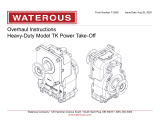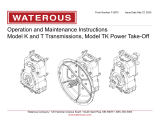Page is loading ...


Table of Contents
Safety 4
Safety Precautions 4
Introduction 5
Using this Document 5
Viewing the Document Electronically 5
Printing the Document 5
Symbols 5
Identifying Exterior Components—Output Side and Bottom Pan 6
Identifying Exterior Components—Output Side and Top Cover 7
Disassembly 8
8
Tools Required 8
Preparing the Apparatus 8
Best Practices 8
8
8
Draining the Oil 9
Removing the End Yokes 10
Removing the Top Cover 11
Removing the Bottom Pan 12
Removing the Chain 13
Removing the Oil Seal Housing and Bearing Cover 14
Removing the Hydraulic Pump Adapter and Oil Seal Housing 15
Removing the Drive Components 16
Assembly 21
21
Tools Required 21
Best Practices 21
21
21
22
Assembling the Driven Shaft 23
Installing the Driven Components 24
Assembling the Drive Shaft 25
Installing the Drive Components 26
Installing the Output-Side Oil Seal Housing 27
Installing the Bearing Cover 29
Installing the Hydraulic Pump Adapter 30
Installing the Input-Side Oil Seal Housing 31
Installing the Chain 32
Installing the Bottom Pan 34
Installing the Top Cover 35
Installing the Input-Side End Yoke 36
Installing the Output-Side End Yoke 37
38

4 | 40
Safety Precautions
• Read and understand this document before you begin the overhaul.
• Read and understand all the notices and safety precautions.
• Be aware that these instructions are only guidelines and are not meant to be
• Do not overhaul this equipment if you are not familiar with the tools and skills
needed to safely perform the required procedures.
• Do not modify the equipment.
•
notice.
Do not touch the surface
during operation––allow
it to cool after operating.
Hot surface can burn you.
Hot Surface
•
•
Drain the pump after use
and before servicing.
Liquid ejected at high
pressure can cause
serious injury.
High Pressure
•
•

5 | 40
Use this document to overhaul your Waterous equipment. Please understand
the following conditions:
• Be aware that these instructions are only guidelines and are not meant to be
•
described in the illustrations or instructions, to perform the overhaul.
• The equipment described in this document is intended to be overhauled by
a person or persons with the necessary skills and knowledge to perform the
overhaul.
This document is divided into the following sections:
This section describes general precautions and alert symbols that are in this
document.
This section is an overview of the document.
This section describes disassembly procedures.
This section describes assembly procedures.
Using this Document
Use the guidelines below when viewing this document.
Viewing the Document Electronically
• View this document in landscape orientation.
• Use the table of contents to navigate directly to that section.
• Text with this appearance is linked to a reference.
Printing the Document
• The document is viewed the best when printed in color.
• The print on both sides and ip on long edge features can provide the
best results.
• Use a 3-ring binder to store the document.
Symbols
Symbols are used to illustrate additional tools or operations that are required to
complete the instructions.
Arbor press—This symbol tells you to use an arbor press to
complete this step.
Discard—This symbol tells you to discard or recycle the part in
accordance with local regulations.
Finger tight, then quarter turn—This symbol tells you to secure the
an additional quarter turn.
High-pressure grease—This symbol tells you to apply high-
pressure grease to the surfaces that you are pressing together.
Sealant—This symbol tells you to apply an appropriate sealant to
the part.
Anti-seize—This symbol tells you to apply anti-seize to the part.

8 | 40
• Read and understand the instructions before disassembling the equipment.
• Prepare a workspace suitable to accommodate and support the power take-
•
•
described in the illustrations or instructions to perform the disassembly.
• This equipment is intended to be disassembled by a person or persons with
the basic knowledge of servicing similar equipment. Contact Waterous with
questions.
Tools Required
• Typical automotive mechanics hand tools.
• Suitable arbor press.
• Suitable support and lifting equipment.
Preparing the Apparatus
• Park the apparatus on a level surface in a well-lit area.
• Engage the parking brake.
•
• Allow the apparatus to cool before servicing.
Best Practices
• Remove any dirt, sand, grease, or oil from the enclosure before you
interior and prematurely wear internal parts.
• Only use a clean, lint-free cloth, a debris-free work surface, and properly
maintained tools to perform the disassembly.
• Replace any gaskets and O-ring seals during the overhaul.
• Do not reuse the self-locking nuts.
• Apply penetrating oil to screws and nuts before disassembly.
Removing the PTO for overhaul varies by application. Your application
may require components such as cooling lines, support brackets, plumbing
connections, and other accessories be removed or disconnected before
removing the PTO.
Record the process used to remove the equipment from the apparatus. Use
this information to install the equipment into the apparatus after the overhaul.
•
order.
Note: Documents specic to your application are available through the
MyWaterous login at Waterousco.com by entering the serial number
for your system. Depending on the application, the serial number
for your equipment is located on the operator panel, pump, PTO, or
some combination of the three.
• Use established industry practices to disassemble the PTO.
• Record or mark components as you remove them to make sure that you
install them in the same orientation.
•
with your local regulations.

9 | 40
Draining the Oil
1
2
Use the illustrations and instructions to drain the oil
1 To drain the oil, do the following:
• Use the oil level plug to approximate the
amount of oil in the PTO.
• Place a suitable container under the PTO to
collect the drained oil.
• Locate and remove the oil drain plug.
• Allow the oil to drain.
2 Install the oil drain plug.
Note: Make sure that you do not over-tighten
the oil drain plug.

13 | 40
Removing the Chain
1
2
3
Use the illustrations and instructions to separate
and remove the chain.
1 Locate the connecting link.
2 Use side cutters, needle-nose pliers, or a
similar tool to remove the cotter pin.
Note: Replace the cotter pin if it is damaged
during removal.
3 Remove the connecting pin set, then remove
the chain.

14 | 40
Removing the Oil Seal Housing and Bearing Cover
1
3
Use the illustration and instructions to remove the
oil seal housing, bearing cover, and associated
components.
1Remove the mounting hardware, then remove
the oil seal housing and oil seal.
2 Remove the O-ring and wave spring, then
discard the O-ring.
3Remove the mounting hardware, then remove
the bearing cover.
4 Remove the O-ring and wave spring, then
discard the O-ring.
2
4

15 | 40
Removing the Hydraulic Pump Adapter and Oil Seal Housing
1
Use the illustration and instructions to remove
the hydraulic pump adapter, oil seal housing, and
associated components.
1Remove the mounting hardware, then remove
the hydraulic pump adapter and oil seal.
2 Remove and discard the O-ring.
3Remove the mounting hardware, then remove
the oil seal housing and oil seal.
4Remove and discard the O-rings.
5 Remove the tube.
2
3
4
5

16 | 40
Removing the Drive Components
1
3
24
Use the illustrations and instructions to remove the
drive shaft and associated components.
1 Remove the oil seal sleeve from the drive
shaft.
2 Use an arbor press to remove the drive shaft
and bearing.
3 Remove the spacer and drive sprocket from
the chain case.
4 Use an arbor press to remove the bearing.

18 | 40
Removing the Driven Components
1
2
3
Use the illustrations and instructions to remove the
driven shaft and associated components.
1 Use an arbor press to remove the driven shaft
and bearing.
2 Remove the spacer and driven sprocket from
the chain case.
3 Use an arbor press to remove the bearing.

Notes
/

















